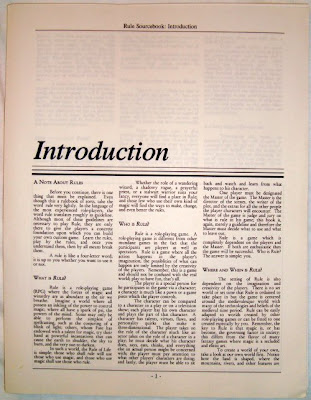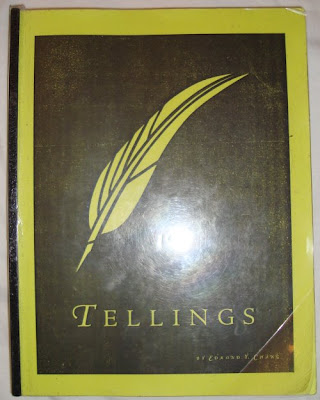Rule of Magic (circa 1990) was the high fantasy game that I wanted to write, a game that celebrated spells, mages, and magic. I wanted to get away from the stereotypical, traditional philosophy that magic was rare, unnatural, corrupting, or vestigial. It is the philosophy that deems mages physically "weak" and esoterically "strong," that severely limited magic users on the one hand and yet gave them free reign in the end game on the other. I understood that this was a game balance issue, a mytho-cultural set of expectations. So, I wanted to design a game that challenged these ideas (or at least complicated them). Here (below) is the character sheet for Rule of Magic. (Yes, it was done on a very old Tandy with a desktop publishing program a step up from PrintShop and printed on a dot matrix!)


Rule of Magic became Rule (circa 1991). In a day and age of pen-and-paper gaming that became increasingly obsessed (even myopic) about game worlds and world-building, I wanted my game to be about game concepts and game building. I decided to focus on a game that would serve as a template system (and not a universal one) that provided players with a solid foundation of mechanics, character creation, and frames over which they could impose whatever world they desired. In other words, I wanted a great game first and a great world second. Rule of Magic and Rule have lineages to systems like Champions and AD&D (which were the games I played at the time).
Here (below) is a Rule character sheet and a few chapter title pages. (I think I graduated to my first laser printer by now, and my layout skills were getting better, too.)




In 1992, Tellings was born. The game was slowly evolving. Character creation became more fully point-based, skill-based. Though, the early versions of Tellings outlined "disciplines," which were not classes per se. Rather, characters were Rule of Steel, Rule of Stealth, Rule of Faith, or Rule of Magic. These "Rules" set parameters for skill and ability costs. Though a Rule of Steel did not begin with magic, they could still learn it at an increased cost. (This system carried over to and remains in Archaea, my live-action role-playing game, which was taking shape right about this time, too.)
The first "reader's copy" of the Tellings rulebook (1992) was a simple Word document, single-sided, and spiral bound (see below). The evolution of the book would take leaps and bounds afterward. The very first copy of Tellings did not even have a spell list or a prayer list!

Around 1994, the look, mechanics, and philosophy of the game "graduated" so to speak and served as the foundations for all subsequent iterations of the game. I finally got hold of a robust desktop publishing program, PageMaker, and went to town with the book's layout and design.
The game also dropped the archetypal "Rules" and became a full-fledged "classless" system. The first edition of Tellings (see below) was a sleek number -- only about 250 pages -- and included a more developed magic system and prayer system. One of the things that did carry through from Rule of Magic was an attention to the way magic worked, the way magic was accessed, the way magic was invoked, and the way magic was adjudicated. Mage magic -- arcane magic -- would be markedly different than priest magic -- divine magic -- because they had different sources, different philosophies, different advantages, and different limitations.

The 1996 version of Tellings (below) was grew to 312 pages! The rulebook developed a fuller game master section and (at the behest of players) more spells and more prayers. The twin quills of the previous edition was edited to a single (more tasteful and less suggestive) quill. The quill would become the logo of the game.

Two versions of Tellings would come out in 1997. Again, the books rarefied the Attribute system, the skill list, the Strength and Weaknesses list, and the core combat, magic, and prayer rules. Books #4 & #5 would be almost 350 pages long! The rulebook, by now, also boasted an extended index. I was always bothered by how skimpy and sometimes confusing gaming book indexes were. I wanted Tellings to be useful, functional, and as complete as possible.


Shortly after a major move from Maryland to San Francisco, a sixth book (1999) and seventh book (2000) came out (below). Because self-copying the books were becoming prohibitively difficult (not to mention expensive), I decided to reduce the interior font by a small margin, to cut unnecessary pages, and to reduce the number of pages without reducing any important content. In fact, the game gained in material (once again in the spell and prayer department) but was a fit, trim, fighting weight of 318 pages. The seventh book got a lot of use!


Book #8 (2005) was released after some time. (I had moved back to Maryland in the meanwhile.) It was a further refining of the rulebook. Somewhere along the way, it gained in content returning to a healthy 346 pages. Book #9, which is really an updated version of the last book, came out in 2007. It is the current rulebook that I use.


Next year's book, which will be a fortuitous Book #10, will hopefully be the last version for some time. (That's what I have been saying for the last twenty years.) I do feel that the game is "done," though, even though I want to keep editing, proofing, and perfecting. I suppose the spirit of making a great game, of great game making is what keeps Tellings going.